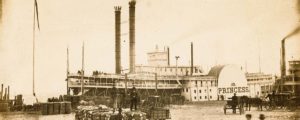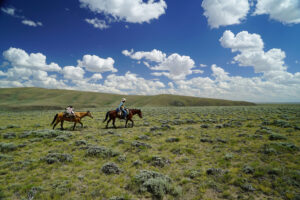On July 5, 1851, a Mexican woman became the only woman ever hanged for murder in the state of California. She was charged with killing Frederick Cannon, a white man, in the gold mining town of Downieville. The incident has become part of northern California’s Gold Rush lore, but details about what happened vary widely. Even the woman’s name has been the subject of speculation—she has been called “Josepha,” “Juanita” or simply “the Spanish woman.”
Maythee Rojas, a literary critic and professor of women’s studies at California State University, Long Beach, was studying newspaper accounts of the incident and miners’ recollections of it when she unearthed a Spanish-language source that had been overlooked by historians. The source identifies the woman as Josefa Loaiza and provides other key information about the aftermath of the murder.
What is generally agreed is that the miners were celebrating Independence Day, California’s first since statehood, with great enthusiasm. Cannon and some friends were walking by Loaiza’s house when, in a drunken stupor, he either broke down or fell through the door, which hung on leather hinges. When Cannon emerged some time later, according to the testimony of his friends, he was carrying Loaiza’s scarf. Many believe that Loaiza was raped, though there is no direct evidence to support that theory.
The next day, Loaiza, her husband, Jose, and Cannon got into an argument over replacing the door. Cannon called Josefa a whore; she challenged him to come into her house if he was going to insult her. Cannon followed Loaiza inside, and she stabbed him in the heart. He died within minutes. By afternoon, townsmen had formed a kangaroo court and appointed a local rancher as judge. Loaiza was hanged before nightfall.
What were Jose and Josefa Loaiza doing in Downieville?
Jose was a monte dealer at the Craycroft Saloon in town. Josefa also worked in the saloon; she was a waitress. Many Mexicans initially came to the area to mine, but they were pushed out by the Anglo miners. So they ended up doing service work to sustain themselves. The majority of Mexicans were from the state of Sonora, which had an established gold mining industry. The majority of American miners who crossed over to the West had not worked in that capacity. They would try to get the Mexicans to help them figure things out and then turn on them as rivals.
What happened the night of July 4?
Unfortunately, I think it’s impossible to ever really know. People try to push me to say that she was raped, but there’s no evidence for that. It’s certainly not impossible, and there are a lot of good reasons why we could assume that. Even if that’s not physically what happened to her, her home was invaded, her property was taken and she was definitely verbally assaulted. There are witnesses to the language that was used, and there’s an attitude on the miners’ part about what they felt they could do to a Mexican person, and, more specifically, a Mexican woman in that environment. I think that’s what’s key.
I didn’t discover Josefa. Historians have known about this story for a long time and have felt frustrated by the lack of documentation. I’m not a historian, and I’m not pretending to be. What I attempted to do, as a literary critic, was to look at all the competing narratives, the ones that were initially produced by the reporters who were there, the way in which miners later reflected on the situation and the way in which the town of Downieville—which became infamous for this—handled it. I wanted to get a sense of how memory works and how competing stories attempt to tell the truth.
What did you find that previous histories had missed?
I found an account in a Chilean newspaper on microfilm at the California State Library. I got really lucky. It was in Spanish, and I think it got overlooked because most of the research has focused on English-language sources. In this account, Jose tries to fight off Cannon and his buddies. Then Jose’s held down while Josefa is raped, and he yells at her to grab the knife from under the bed and stab Cannon. I interpret this as a way for the writers to prove Latino manhood, to get away from the emasculation that was common in the way white men treated them. Although it doesn’t hold any more validity than other accounts, I think it’s important to note that Jose is represented as fighting back, and that the white men are represented in terms of their violence. The newspaper also notes that Jose’s life was spared, but he was told never to return to Downieville.
Also there is one detail that I was able to document in the California justice records. Jose went back to Mexico and filed a claim against the state of California for hanging his wife. He asked for $300,000. The case was ultimately dismissed, and he did not get that money.
Interestingly, one of the things that has been consistently missing from the story is Josefa’s real name. Given the horrible thing that had happened to her, to not even have a name—to be disembodied even of an identity—was really disturbing to me. Her first name has been mangled and she’s never been given a last name. Neither has Jose. But in this record, his full name, Jose Loaiza, is printed.
What do the narratives say about Josefa’s death?
The majority of the accounts say that she really held her composure during the entire process, and several recount that she said, “I would do the same again if I was so provoked.” I think it implies that Josefa was committed to her actions and understood the consequences. Many white miners who reflected on it later said she was brave. She stands up against a very hostile situation and certainly a very sexually dangerous environment for women, and did what she felt was right. She defends herself, which is sort of a credo during that time period—an eye for an eye.
Some people got really wild with their comments in later accounts and accused her of having killed many times. They focused on the fact that as a Mexican, she was more disposed to that kind of behavior, so they really heightened a lot of that.
One of the more macabre versions was from a man who claimed that he had gone to some sort of secret ritual for a society and that they were using Josefa’s skull. To me, it was such a great metaphor. I felt like they dismembered her figuratively and then literally. And you can’t completely discredit it. Josefa was buried next to Cannon, and a flood later destroyed the burial ground. His body was recovered, but it’s unclear what happened to her body. That somebody may have taken her head is not out of the realm of possibility. In terms of the miners’ extended narratives, it’s such a telling detail.
Originally published in the December 2007 issue of American History. To subscribe, click here.




